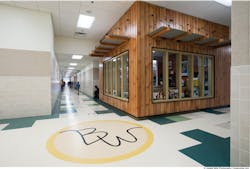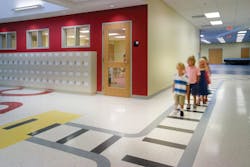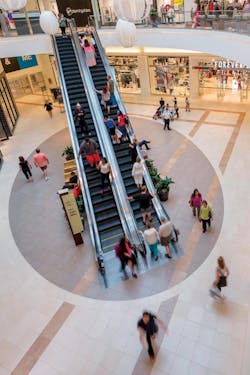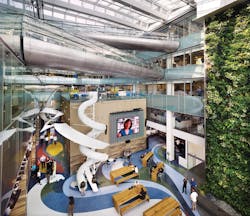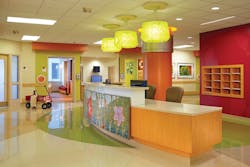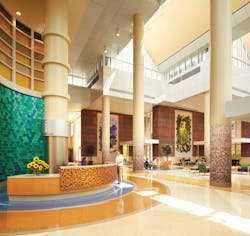Emerging trends in commercial flooring
Rectangular tiles, digital graphic applications, the resurgence of terrazzo, and product transparency headline today’s commercial flooring trends. New product technologies and more extensive manufacturing information will expand choices for the Building Team in all types of projects, including healthcare, academic, hospitality, retail, and workplace.
Moving away from standard 12x12-inch tile, rectilinear plank shapes—often, 12x24-inch—are gaining popularity. Designers are also specifying hexagonal tiles for carpet and resilient flooring products. “The installation of these shapes and combining different color options can really activate the flooring in the designs we create,” says Lori James, IIDA, LEED AP ID+C, Lead Interior Designer, Project Manager at SmithGroupJJR (www.smithgroupjjr.com), and a member of BD+C’s 40 Under 40 Class of 2012.
Color and texture continue to exert a strong influence on user perceptions. Some designers try to strike a balance between “unique” and “timeless,” but others are opting for lively, trendy shades such as hot pink, teal, and electric blue.
Lori Mukoyama, Principal, RTKL Commercial Practice Group (www.rtkl.com), says many Building Teams are trying to reinvent traditional patterns. “For example, you’ll see a traditional plaid with a new twist, such as a fun color or more modern look. You also might see a traditional houndstooth pattern but with a larger scale, making it appear more dramatic,” she says.
This article is worth 1.0 AIA CES HSW learning units. To earn the LUs, study the article carefully and take the exam posted at www.BDCnetwork.com/flooringtrends.
Caroline Robbie, Principal, BID, AOCA, ARIDO, IDC, NCIDQ, Quadrangle Architects Limited (www.quadrangle.ca), sees the popularity of fashion designer Paul Smith’s iconic stripes filtering down to flooring in the form of striped carpets and striated tiles. “Another ongoing trend is significant improvements in the photographic application of natural textures onto laminates and other substrates,” she adds. “People are still looking for a natural product appearance and are willing to use these photographic products to achieve that look.”
Advanced digital graphics on porcelain tile combine the natural look of materials such as marble, stone, and wood with the economy, durability, and maintenance advantages of porcelain. Kim Ferguson, Associate and Senior Interior Designer at LEO A DALY (www.leoadaly.com), points out that faux-wood-on-porcelain tiles are now available in saw-cut, smooth, and distressed textures in both traditional and modern color palettes.
RTKL’s Mukoyama notes the emergence of abstract patterns inspired by nature, as opposed to directly copying natural elements or scenes. “No longer are there ‘travertine-looking’ tiles, but rather a tile that has movement and tones abstracted from travertine,” she explains.
Building Teams seeking highly durable, attractive surfaces are also taking a second look at terrazzo. While terrazzo’s high first cost has traditionally discouraged owners, specifiers note that the material is making a comeback based on its longevity, low maintenance requirements, and ability to incorporate recycled materials.
In addition to morphing aesthetic demands, owners and Building Teams are looking for higher levels of sustainability—particularly with the recent release of LEED v4 and its new product transparency requirements. As more manufacturers begin listing environmental and health data for their products, sustainability claims will become more verifiable, and designers will no longer have to conduct such intensive independent research.
“From a designer’s perspective, this is extremely important and will help eliminate greenwashing and false sustainable advertisements,” says James.
The Resilient Floor Covering Institute’s FloorScore program and the Tile Council of North America’s Green Squared certification can provide useful guidance. In addition, specifiers can look to the Health Product Declaration Collaborative, www.hpdcollaborative.org, and Declare, www.declareproducts.com, for valuable information about healthy flooring products.
VENDORS OFFER NEW CHOICES IN CONVENTIONAL MATERIALS
With sustainability as a backdrop, a significant increase in options, variety, and technological advances is making familiar flooring materials more appealing for Building Teams and their clients. Development is occurring in all the standard categories, including hardwood, carpet, resilient, terrazzo, and concrete.
Hardwood and its substitutes. Although more popular in the residential market, hardwood flooring still enjoys a legion of fans in the commercial AEC industry. Some commercial designers are taking cues from high-end residential architecture—a field whose practioners have long understood the value of natural wood for adding warmth and comfort.
“Wide-plank wood flooring is in high demand, and we are also specifying end-cut wood floors as well as very narrow planks depending on the environment,” reports LEO A DALY’s Ferguson, who is Past President of the American Society of Interior Designers Nebraska/Iowa chapter. RTKL’s Mukoyama is seeing a lot of distressed hardwood in funky new treatments, such as layouts that contrast dark and bleached tones, or varying wood tile prints in a single strip of flooring.
Reclaimed wood, available in a variety of species, remains popular as an attractive, sustainable option. “The idea of using reclaimed wood can help leverage the sustainable story and offer a second life for a material that once existed at the bottom of a lake, or as a barn, fencing, paneling, or siding,” says SmithGroupJJR’s James.
Concerns about scratch and moisture resistance and higher maintenance requirements can discourage commercial building owners from embracing real wood. Faux wood products, such as luxury vinyl tile (LVT), porcelain, or vinyl sheet goods laminated with wood prints, are becoming increasingly popular, especially as the level of perceived “authenticity” improves. Available in sheets and planks in varying widths to resemble the look of cut wood, faux wood is showing up more often in venues such as hospitals, medical office buildings, and residence halls.
Wood-look resilient material has its tradeoffs, says Angie Clarkson, LEED AP BD+C, a registered interior designer at architecture and interiors firm LWPB (www.lwpb.com). “On one hand, LVT is never going to feel the same underfoot as a natural hardwood floor. Any imperfections in the substrate will certainly transfer to the surface, just like any 1/8-inch-thick product. On the other hand, it gives designers a whole world of exotic wood species at their fingertips. You want the look of an endangered African rosewood? You’ve got it without the long lead times or the ecological guilt.”
Carpeting. Carpet tiles continue to dominate the commercial carpeting marketplace, and are estimated to account for 55 to 60% of carpeting contract sales. Tile products offer extensive design flexibility, and it’s much easier to replace worn or damaged tiles than to fix a problem with broadloom carpet. Initial installation produces less waste, and some tile products no longer require adhesives.
With vendors offering an ever-shifting mix of styles, colors, shapes, and patterns, designers have free rein. Beyond the traditional squares, manufacturers have introduced rectangular planks of 24x48 inches, skinny tiles of 25 centimeters x one meter, mega tiles of 36 inches square, and hexagon-shaped tiles.
“For many of our projects, we look at mixing product styles and color to create an intentional design experience when the users and guests move throughout the space,” says James. “This approach also gives designers an opportunity to change the experience from space to space by modifying the products we specify.”
Broadloom still has a place in budget-driven projects, says Ana Pinto-Alexander, RID, IIDA, EDAC, Principal and Senior VP and Director of Healthcare Interior Architecture at HKS (www.hks.com). In addition, coordinating broadloom with modular carpeting can enable designers to maintain a consistent design, yet save some cash by specifying broadloom in lower-traffic areas such as conference rooms and private offices.
Another notable development in carpet products has been the emergence of new fiber formulas—some of them involving recycled waste—that offer increased softness or better stain protection and durability. In the broadloom market, for instance, a newer silk-like weave lends a luxurious feel and luster. Other products incorporate Nylon 6,6, a commercial polymer with a chemical structure that conveys additional strength and stain resistance, or Nylon 6, once considered a “value” product but the subject of recent technological improvements. Manufacturers are creatively using post-consumer waste such as fishing nets, textiles, and fluff from the tops of old carpets and rugs.
Resilient flooring. In this category, commercial-project designers generally lean toward vinyl composition tile (VCT), LVT, linoleum, and rubber. “The qualities that make resilient flooring choices stand out are the color and texture offerings, sustainable properties, and ease of maintenance requirements,” says SmithGroupJJR’s James.
If initial cost is the overriding factor, VCT often trumps other options. No longer limited to 12x12-inch tiles, VCT is now available in a variety of sizes and patterns.
Linoleum offers renewable, natural properties and textural warmth. “The design possibilities are almost limitless given a great installer and some imagination,” says Quadrangle’s Robbie, who teaches design courses as an adjunct professor at Ryerson University and Ontario College of Art and Design.
The same can be said for LVT, especially since wood and stone patterns are becoming more and more realistic. Vendors are also coming up with appealing options for installation, according to LWPB’s Clarkson. “Multiple LVT manufacturers are unveiling floating floors, which are planks or tiles that interlock and do not need to be glued to the substrate. One notable advantage of these floating floors is the option to install planks directly over existing VCT or ceramic. In a renovation project, the material cost of LVT may be higher than that of VCT, but by foregoing demolition and floor prep costs, the total installed cost of LVT can be brought a lot closer to that of VCT.”
Clarkson also notes that bio-based tile (BBT), sometimes called “VCT’s younger brother,” is gaining interest. Made from rapidly renewable material such as corn husks, and often PVC-free, BBT can handle static and rolling loads, whereas VCT cannot. Even in more traditional resilient flooring categories, manufacturers are finding ways to avoid phthalates, which have been proven to cause reproductive problems in lab animals. Through the use of more natural plasticizers, products are still able to offer good levels of flexibility and durability.
“In addition, we are seeing no-wax resilient flooring, which is a response to the environmental concerns as well as the maintenance issues of stripping and re-waxing, especially within buildings that operate 24/7,” says LEO A DALY’s Ferguson. “Certainly, the availability of regional and recycled-content materials continues to improve, and the market is much more aware of indoor air quality concerns. A resource such as The Living Building Challenge’s Red List of hazardous chemicals is very helpful.” (For more, see the “Materials” section at https://ilbi.org/lbc/LBC%20Documents/LBC2-0.pdf.)
Terrazzo. For those who can get past the first cost of terrazzo, HKS’s Pinto-Alexander assures that a great long-term ROI is in store. She reports seeing more terrazzo in large entrance lobbies and primary public circulation areas for corporate, healthcare, sports, and higher education venues.
“Seamlessly smooth transitions are respectful to wheelchair users and others with challenges in physical mobility, while accommodating dynamic patterns. Manufacturers offer an array of transition strip options,” she says.
Polished concrete. Although polished concrete isn’t appropriate for every site, these floors are continuing to find a place in retail, corporate, sports, and specialty healthcare settings. “We are taking advantage of increased options and control in polished concrete dyes and scribed patterns,” says Pinto-Alexander. “New advances in pigment chemistry are more sustainable and better at covering flooring substrate imperfections. They offer specialty effects that are more predictable than traditional acid stains.”
Because concrete is so customizable, Ferguson says, it can be appropriate for a variety of environments. “Whether the desire is a monolithic natural concrete color or colored ground with stainless strips to create a terrazzo-patterned effect, concrete can achieve this. In addition, it is durable, easy to clean, and environmentally sustainable.”
While Robbie is also a big fan, she is currently experiencing some resistance in clients’ willingness to use concrete as a finished floor. The “brick and beam” warehouse workplace is trending toward grittier finishes, she says.
HOW TO SELECT THE RIGHT MATERIAL FOR EVERY COMMERCIAL PROJECT TYPE
With such a broad range of choices available, product specification can be quite a challenge. Experienced designers offer some general rules of thumb for various applications.
Healthcare. No-wax resilient sheet and tile products—including rubber, linoleum, sheet vinyl, and vinyl tile—dominate in healthcare. Some designers select carpet tile or terrazzo to meet healthcare facilities’ needs for “rollability,” smooth transitions, and slip resistance.
Infection control and biological containment are crucial factors for many clients in this sector. “Over the next five to 10 years, it will be interesting to see makers of products that are nontraditional for healthcare, such as carpet and modular products, attempt to produce metrics showing that ‘hard and shiny’ is just as capable of supporting biohazards as ‘soft and matte,’” says Quadrangle’s Robbie.
K-12 and higher education. The need to provide rugged surfaces for an economical price drives most decisions in this market, according to Robbie. “Education, like healthcare, has the burden of maintenance and durability as the primary deciding factors. Combine that requirement with severe cost constraints, and the choices for flooring in educational environments become very limited.”
VCT, porcelain, linoleum, broadloom, and carpet tiles are often specified for school and college projects. Terrazzo and polished concrete are often used in main-floor public spaces, and natural wood and rubber are typicially specified in gyms and other recreational areas.
Retail. Retail and restaurant projects are largely governed by aesthetics and branding, which gives designers more latitude and a greater selection of product choices. “The primary drivers in retail settings are company brand, regionally influenced high-impact aesthetics, ease of maintenance, first cost, and recognition that retail entities are often required to update interiors frequently to keep up with market completion,” says HKS’s Pinto-Alexander. The sector’s most popular product types are carpet tile, natural stone tile, and wood. Polished concrete, LVT, and porcelain tile can be found as well.
Workplace. As with retail projects, flooring choices for offices must tie into the organization’s brand and regional aesthetics. Durability requirements will vary based on each space’s purpose within the larger project. “The way a boardroom is finished tells the visitor about the company, but the copy room only needs to be durable,” says Robbie. “The choices for flooring products change with these functional needs, along with the constant balance of cost, quality, durability, installation, and ease of maintenance.”
Topping the list of go-to products for offices are carpet tile, broadloom carpet, and no-wax vinyl resilient sheet goods and tile, according to Pinto-Alexander. Ferguson is seeing stone, porcelain, wood, and cork flooring making inroads in this sector.
Hospitality and sports venues. Similar to retail sites, hotels must be prepared to frequently update their interiors. Broadloom, carpet tile, and large-sized natural stone tiles are frequently selected, according to Pinto-Alexander. For sports facilities, dealing with heavy traffic and long-term durability are important, and designers often choose polished concrete, rubber, hardwood, and carpet tile, depending on the use of each area.
Space type also governs choices of color and pattern, with each market sector showing some distinct trends. Says Pinto-Alexander, “Classic, modern, monochromatic neutrals and subtle tailored patterns still play a large role in corporate and hospitality settings and are on the rise for healthcare. Large-scale geometric and organic patterns, as well as sculpturally textured carpets, continue to play a strong role in hospitality settings. Brighter, more vibrant palettes that are fresh and transparent are now more prevalent, and are especially popular in pediatrics and high-energy corporate and sports settings.”
FIRST COST VS. LIFE CYCLE: HOW TO STRIKE AN APPROPRIATE BALANCE
First cost has traditionally driven flooring decisions—often inhibiting the specification of better quality, more expensive systems. Particularly in facilities such as K-12 schools, decision makers have frequently been very restricted by initial budgets, hoping that O+M funds would be sufficient to sustain their buildings over time, according to Clarkson.
This scenario has begun to change. Many facility owners, even school districts, are taking a more long-term view. Low-maintenance and durable choices such as rubber, LVT, porcelain, and polished concrete are being given a fairer analysis, despite their higher first cost.
Essentially, says Robbie, it’s all about balance. Because every product entails strong points and tradeoffs, life cycle performance should logically be given the most emphasis. In Quadrangle’s experience, many clients appreciate that reduced operational costs over the floor’s lifetime do ultimately improve their facility and their bottom line.
Nevertheless, budget frequently continues to win out. “I try to choose a product that will stand up to wear and tear, but if it’s not in budget, there’s no point in even considering it,” Mukoyama says.
When there is an opportunity to encourage clients to take the long view, it can be helpful to get the facilities maintenance director and staff involved. “If a new flooring product is being introduced into a facility, create a mockup area where foot and cart traffic is comparable to anticipated traffic and have the facility staff test it out,” suggests Ferguson.
Architects at Quattrocchi Kwok Architects (www.qka.com) conduct initial research using manufacturers’ literature, and seek feedback from current and past clients on product performance. They then request multiple 2x2-foot samples to give end-users a better idea of the look and feel of the flooring, particularly with regard to color and large-scale patterns, explains Mark Quattrocchi, AIA, Principal and Founder of the firm.
In addition, end-users need to be educated about maintenance requirements, particularly if these will be different than what the staff has been accustomed to. Even in situations where a new product means less maintenance, such as rubber flooring replacing VCT, end-users still need to be made aware that rubber is naturally less shiny than VCT, which sparkles after every polish.
The Choosing By Advantages Decisionmaking System, a book by Jim Suhr, can help Building Teams weigh first costs and long-term expenses. Often abbreviated as CBA, the Choosing By Advantages system has been adopted by numerous government agencies, notably the Forest Service, and by some AEC firms.
For example, a resilient floor will typically last 20 to 30 years, if properly maintained. Once owners are made aware of this information, they can more easily see the benefit of increasing the project budget, using contingency funds, or evaluating another part of the design to afford options with a long life, says Pinto-Alexander. “In most cases, a facility can see a return on investment in as little as three to five years.”
Adopting the principles of CBA into their own analytic spreadsheet, HKS helps clients make evidence-informed decisions based on an understanding of each project’s hierarchy of priorities. In the recent design of Simon Family Tower at Indiana University Health’s Riley Hospital for Children, in Indianapolis, sheet vinyl, VCT, and bio-based tile emerged as the most “advantageous” flooring options after CBA analysis. (See page 72.)
Pinto-Alexander also recommends a guide developed by the Center for Health Design, which details product performance characteristics and the physical composition of various flooring materials. In addition, CHD’s Evidence-Based Design checklist, available at www.healthdesign.org/sites/default/files/tandusflooringreport_final.pdf, can be very helpful.
Specifiers can also avail themselves of life cycle analysis tools offered by the Carpet and Rug Institute and the Tile Council of America, in addition to a number of resilient flooring manufacturers. However, Robbie points out that using such tools can be rather time consuming, and that personal experience is often the best indicator of a product’s life cycle cost. “There is nothing like a failure to remind us of the balance that must be struck between cheap initial cost and the durability of a product,” she says. Robbie also recommends reaching out to facilities management companies for solid information on costs for flooring maintenance and replacement.
Of particular interest to those who do healthcare projects, a 15-year study by Florida Hospital’s Office of Design tracked the total average cost of maintaining 1,000 sf of VCT, sheet vinyl, rubber, and carpet. Rubber, by far, offered the best life cycle value. Similarly, in a study conducted by an interior designer at Burt Hill before that firm merged with Stantec, rubber, bamboo, and hardwood were found to be the most cost-effective choices for healthcare installations over the course of 15 years. VCT came in at triple the cost of these options once maintenance expenses were factored in.
Regardless of the flooring type or application, one thing is certain: Building Teams have more product choices than ever before, lending unprecedented levels of design freedom. As industry knowledge of product health, performance, and life cycle costs becomes more prevalent, specifiers will be able to make even more informed recommendations on the best flooring for every project.
Decision methods produce choices tailored to healthcare
Tasked with designing the new 10-story Simon Family Tower for Indiana University Health’s Riley Hospital for Children in Indianapolis, HKS decided to take a step back between the project’s two phases in order to thoroughly evaluate assorted flooring options. Vinyl composition tile had been specified for the med/surg patient floor corridors and support spaces that were completed in 2011.
For the second phase, the design team took a hard look at using rubber vs. sheet vinyl in the corridors and support spaces. The same analysis was done for the remainder of the Phase 2 flooring systems.
“Exploration of the decision-making process related to an array of flooring materials with analytics on first costs and long-term ROI, including comparison of maintenance costs, reasons for design team recommendation, and reasons for final client selections,” says Ana Pinto-Alexander, RID, IIDA, EDAC, Principal and Senior VP, Director of Healthcare Interior Architecture at HKS.
By applying Choosing by Advantages methodology through their own proprietary worksheet, designers evaluated attributes, or “Factors,” of each flooring product. The “Factors” were assigned “Advantages.”
“The client then gave the most important Factors and Advantages the highest scores,” explains Pinto-Alexander. “The least important Factor and Advantage was given the lowest score. At the end of the exercise, the preferred product had the highest score. This score can then be compared to initial product cost, helping the client make an educated decision on initial cost and ROI.”
Ultimately, the hospital went with the majority of the design team’s recommendations, which included the following:
• Main lobby: terrazzo. “Terrazzo has been a standard in the hospital for all of their first-floor corridors and public entrances. It is a great product for aesthetics, cleanability, and durability,” reports Pinto-Alexander.
• Patient floor corridors and support spaces: rubber. The environmental services team toured several comparable hospital facilities, helping them overcome initial thoughts that the floor had to be waxed to be considered clean. In addition, the owner came to the realization that rubber offered a better long-term ROI than VCT, plus ease of maintenance, infection control, and sustainability.
• Patient rooms: sheet vinyl. The flooring type was chosen based on its faux-wood warmth, no-wax cleanability, durability, and seamless finish.
• Waiting areas: carpet tiles. The tiles were selected for pattern, durability, and ease of changing out stained tiles.
• Offices and conference spaces: broadloom carpet. As a low-cost alternative to carpet tile, broadloom was able to maintain the desired aesthetic with a coordinating pattern.
